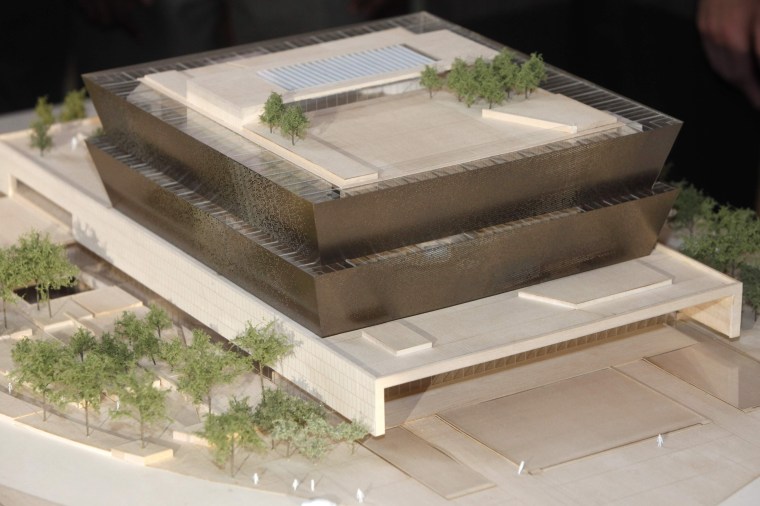A glowing bronze crown meant to evoke historical imagery of African-Americans emerged Tuesday as the winning architectural concept for a new black history museum on the National Mall.
A Smithsonian Institution jury selected the team Freelon Adjaye Bond, in association with SmithGroup, from six finalists in a design competition to build the National Museum of African American History and Culture.
Members of the group previously designed San Francisco’s Museum of the African Diaspora and the Nobel Peace Centre in Oslo, Norway.
The bronze, layered corona atop a stone base would be the defining element of the structure, which could be the last major building added to the expanse between the U.S. Capitol and Washington Monument.
“I think it definitely gave us a very clear position that was different to the other schemes,” said lead designer David Adjaye, 42, who was born in Dar es Salaam, Tanzania, and is now based in London and New York. His parents are both from Ghana. “We are celebrating an incredible journey and looking to the future.”
Allow for natural light
The crown concept, which would allow natural light to flow into the structure through bronze screens, was inspired by images from African and American history, Adjaye said, “this idea of uplifted praise sort of imagery.”
It evokes traditional headdresses worn by African-American women, as well as the colonial crown from Africa and the idea “that a hat-wearing person is a free person ... who doesn’t have to carry a load but could wear a hat,” he said.
The bronze exterior would have a “dynamic and changing view,” depending on the sun’s angle and cloud cover. At night, it would glow with light emerging from its skin, the architects said.
Adjaye, who designed the Nobel Centre in Norway, said winning the National Mall project is the defining moment of his career.
The design process will take up to three years and is subject to approval from groups that oversee architecture in the nation’s capital. Construction is expected to begin in 2012, with an opening slated for 2015.
Congress has pledged to provide half of the museum’s $500 million cost, with private fundraising to cover the rest.
Museum Director Lonnie Bunch said he was looking for a building that would speak of the resiliency, optimism and spirituality of the African-American community.
“This does it,” Bunch said, standing near a model of the proposed design. The shimmering bronze, he said, “talks of a people’s presence, regardless of what happens,” and will mark a change in Washington architecture.
“Even though it’s geometric, it still breaks the kind of neoclassical formality of the rest of the mall,” Bunch said. “I think that’s a good thing to come.”
'Complement the mall'
The Freelon Bond group was familiar to Smithsonian officials, who had contracted it to determine the structural needs for the museum’s galleries and theaters and presented the plan to all of the competing teams.
J. Max Bond Jr., a principal on the team’s planning phase and a prominent black architect, died of cancer in February.
Philip G. Freelon, a North Carolina-based principal of the team, said the museum would complement the mall and its tallest neighbor, the Washington Monument.
“We’re not looking to mimic what’s around us but to complement the mall and the buildings around and also to create a statement of our own,” he said, and the design will evolve. “It’s not a building yet; it’s an idea.”
Freelon has designed prior black history projects, including Baltimore’s Reginald F. Lewis Museum of African American History and Culture.
Remain on view
The six finalists for the project will remain on view at the Smithsonian Castle through Thursday. Visitors had mixed reactions to the various concepts, which all depart from the mostly boxy museums of Washington.
Margaret Gass, 56, of Carlisle, Iowa, got a peak at the designs while visiting her son in Washington.
“It’s stark,” Gass said of the winning design concept, adding that it was not her favorite. Still, she said, “it’s different enough to be recognizable.”
She preferred an oval-shaped design from a team led by acclaimed architect Sir Norman Foster of London. But her son, Charles Bibilos, 31, said the winning design could be a good fit for the city.
“I think this is conservative enough for the mall,” he said. “As a building, I think it fits a little bit better with everything else that’s going on on the mall.”
